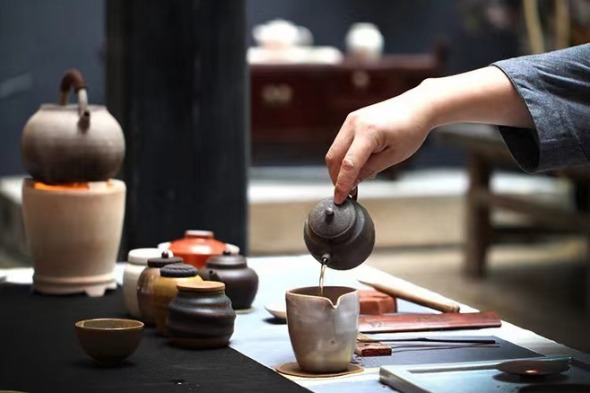Explore China's sacred peak


International students from around the world visit Mount Tai, uncovering its historical significance, spiritual symbolism, and cultural impact while connecting with China's rich heritage.
Among China's Five Great Mountains — Mount Tai in Shandong, Mount Hua in Shaanxi, Mount Song in Henan, Mount Heng in Shanxi, and Mount Heng in Hunan — Mount Tai is widely recognized as the most prominent of these renowned elevations.
The reasons for this reputation have long fascinated Mikhail Milko, a 23-year-old student from Russia studying at Peking University.
Driven by curiosity, Milko traveled to Tai'an in Shandong, the location of Mount Tai, where he joined 10 other young people from around the world for a three-day visit to the city from July 16 to 18.
During a conversation with a guide on Mount Tai, Milko finally unveiled the mountain's significance.
As the highest point in the eastern plains of the Yellow River basin — a region historically important to generations of Chinese people — Mount Tai has served as a refuge during natural disasters such as floods. Also, in ancient Chinese beliefs, climbing Mount Tai symbolized a spiritual connection to ancestors and celestial beings. Particularly remarkable is the tradition of Chinese emperors performing sacrificial ceremonies on the mountain, a practice dating back to China's first emperor Qin Shi Huang (259-210 BC), which has enriched it with cultural value associated with blessings and aspirations.
Abalfazl Delkhasteh, a 29-year-old Iranian student at Tsinghua University, recalled seeing an image of Mount Tai on page 26 of a Chinese passport. This personal experience made his impression of the mountain more vivid. "The breathtaking views and the unique integration of Chinese culture have left a lasting impact on me," he said.
Tang Sinan, a 22-year-old Chinese student at Jinan University in Shandong, noticed something interesting during his interactions with young people from other countries. He found that while many foreign tourists recognized Chinese calligraphy as an art form, they had only a general knowledge of it and couldn't fully appreciate its charm.
However, on Mount Tai, they saw inscriptions left by emperors and literati from different eras on the rocks, each exhibiting a unique style.
"These calligraphic pieces, aged by time, allowed us to witness the elegance of Chinese calligraphy directly," Tang said.
For Olivia Sabine Schubert, a 22-year-old German student at Tongji University in Shanghai, the natural beauty of Mount Tai reminded her of her homeland in southern Germany, where mountains also hold a special significance in local literature and poetry, often symbolizing vitality, strength, and endurance.
The trip allowed her to see that this deep admiration for the wonders of nature, particularly peaks, is not unique to Germany but is a sentiment shared globally.
"In living nature, nothing happens that is not in connection with a whole," quoting the words of the famous German author Johann Wolfgang von Goethe (1749-1832), Schubert expressed her surprise at discovering cultural connections between China and Germany.
"These experiences not only enrich our lives but also foster a sense of interconnected humanity, and at the same time nurture mutual respect," she said.
Maria Regina De Jesus Dominga Uriarte Huang, a 22-year-old US student at Sun Yat-sen University in South China's Guangdong province, was inspired by the Chinese visitors she met at Mount Tai. Among them were an elderly man who had climbed the mountain multiple times and was now accompanied by his grandchildren, and a group of students preparing for exams, who came with their best wishes.
"This made me feel the spirit of Mount Tai and the transmission of its culture," she said.
The legacy of Mount Tai extends beyond the mountain itself and impacts generations in Tai'an city, as seen in the preservation of Taishan shadow puppetry.
As a national intangible cultural heritage of China, Taishan shadow puppetry boasts a history of over 600 years. It distinguishes itself from other shadow puppetry schools through its unique feature of a single performer managing the puppets while also delivering musical accompaniment, singing, and narrating the tales.
Fan Zheng'an, a seasoned master artist in his 80s, stands as the guardian of this time-honored art, having devoted decades to its preservation and promotion.
When Fan's show began, all the young guests were immediately captivated. "While our foreign friends might not grasp the dialogue, the visual and auditory aesthetics enabled this art to transcend language boundaries and resonate with them," Tang said.
"I think it's magical," said Uriarte Huang, admiring how Master Fan managed the entire show by himself, acting as a complete band. "He controlled the music with his feet, sang the storyline, and maneuvered the complex characters with both hands."
Before this trip, Delkhasteh had a basic understanding of shadow puppetry from the cultural programs he attended during his Chinese studies in Iran. However, Fan's show completely surpassed his expectations.
"When I tried to handle the puppets backstage myself, I realized the incredible skill and years of practice required to master this art," he said. "I learned that only a handful of people are capable of performing this art, with two of them being Master Fan's son and grandson."
Ting Hui Ng, a 21-year-old Malaysian student at Fudan University in Shanghai, noted that Malaysia also embraces a similar art form known as Wayang Kulit. Unlike the solo performance of Taishan shadow puppetry, Malaysian shadow puppetry involves several performers. However, they both recount mythical tales from ancient times within their respective cultures.
"I'm from a country closer to China, so I might have missed certain cultural aspects, but participating in such activities with people from diverse backgrounds allows me to look at China in a new light, which is great for painting a full picture of the country," said Ng.
mengwenjie@i21st.cn




































